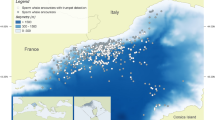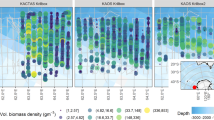Abstract
SINCE the advent, some 25 yr ago, of recording equipment responsive over a wide frequency band, listening stations at scattered ocean locations have recorded long, repetitious trains of powerful, low frequency sound pulses that vary over a narrow 6 Hz band centred at about 20 Hz1,2. Once an enigma, the source of these remarkable signals is now thought to be baleen whales, and although several types of signals have been recorded3, implying that more than one species is responsible, strong evidence implicates the finback whale, Balaenoptera physalus, as one of the generators1. The low frequency acoustic mechanisms of whales are as yet unknown4 but, based mainly on sound propagation theory, it has been both suggested2,4 and vigorously argued5 that the whales use the signals for long-range communication.
This is a preview of subscription content, access via your institution
Access options
Subscribe to this journal
Receive 51 print issues and online access
$199.00 per year
only $3.90 per issue
Buy this article
- Purchase on Springer Link
- Instant access to full article PDF
Prices may be subject to local taxes which are calculated during checkout
Similar content being viewed by others
References
Schevill, W. E., Watkins, W. A., and Backus, R. H., in Marine Bio-Acoustics (edit. by Tavolga, W. N.), 147 (Pergamon Press, 1964).
Walker, R. A., J. acoust. Soc. Am., 35, 1816 (1963).
Northrop, J., Cummings, W. C., and Morrison, M. F., J. acoust. Soc. Am., 49, 1909 (1971).
Cummings, W. C., and Thompson, P. O., J. acoust. Soc. Am., 50, 1193 (1971).
Payne, R., and Webb, D., Ann. N.Y. Acad. Sci., 188, 110 (1971).
Scholander, P. F., Hvalråd. Skr., 22 (1940).
Andreeva, I. B., Soviet Phys. Acoust., 10, 17 (1964).
Ridgway, S. H., Scronce, B. L., and Kanwisher, J., Science, N.Y., 166, 1651 (1969).
Holliday, D. V., J. acoust. Soc. Am., 51, 1322 (1972).
Yamada, M., Scient. Rep. Whales Res. Inst., Tokyo, 8, 1 (1953).
Hosokawa, H., Scient. Rep. Whales Res. Inst., Tokyo, 3, 23 (1950).
Schevill, W. E., in Marine Bio-Acoustics (edit. by Tavolga, W. N.), 307 (Pergamon Press, 1964).
Author information
Authors and Affiliations
Rights and permissions
About this article
Cite this article
BARHAM, E. Whales' Respiratory Volume as a Possible Resonant Receiver for 20 Hz Signals. Nature 245, 220–221 (1973). https://doi.org/10.1038/245220a0
Received:
Revised:
Issue Date:
DOI: https://doi.org/10.1038/245220a0
This article is cited by
-
A pulsed-air model of blue whale B call vocalizations
Scientific Reports (2017)
Comments
By submitting a comment you agree to abide by our Terms and Community Guidelines. If you find something abusive or that does not comply with our terms or guidelines please flag it as inappropriate.



